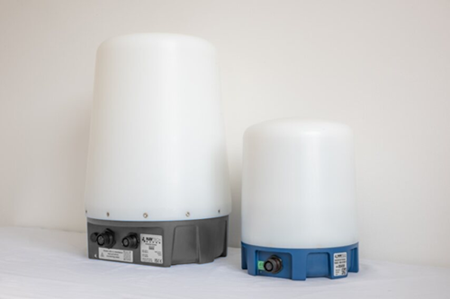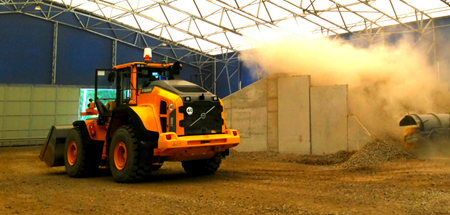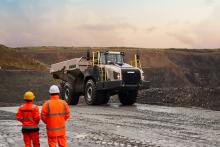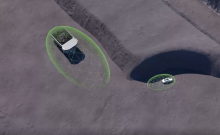
The use of camera technology, lidar, and radar is streamlining operations, giving machines ‘eyes’ to improve processes and enhance safety and productivity in industrial automation. However, there is always one fly in the ointment where quarrying is concerned – dust. Sam Wood, product manager for Navtech Radar, examines how today’s technology is coping with dust and, crucially, how best to tackle it.
Quarrying is conducted in a demanding and often hazardous working environment: adverse weather conditions, crushers, dust, dirt, water and all in an environment where small optimisations can yield massive results and minutes of downtime can cause millions of pounds in downtime.
Safety, rightly, is a top priority for the quarrying sector, and despite notable advancements, the incidence of fatal injuries remains high. In accordance with the Reporting of Injuries, Diseases and Dangerous Occurrences Regulations 1995 (‘RIDDOR’) L0553, employers must report fatalities, major injuries, injuries lasting more than three days, injuries to the public, and hazardous incidents with the potential for causing death or injury.
However, according to the HSE, between 2000 and 2020, more than 3,500 workers suffered injuries which required reporting to HSE, with 31 of those cases resulting in fatalities.

Combined with mining, quarrying is clearly one of the most dangerous industries worldwide, and numerous safety enhancement initiatives have been implemented in the sector, such as Target Zero, a programme under the Quarries National Joint Advisory Committee (QNJAC). This initiative has contributed to a remarkable reduction of more than 80 percent in quarry accidents since the year 2000.
The HSE also reports that “transport accounts for 40% of all accidents in quarries and 60% of all deaths”. As quarries become more automated, the reliance upon sensor technology to guide transport or autonomous trucks has become even greater.
Automated machinery is extensively employed for tasks like drilling, blasting, loading, hauling, and material sorting. Beyond enhancing speed and precision in these operations, automation has the potential to eliminate the requirement for operators to closely interact with hazardous equipment, including crushers. But this doesn’t tackle the fact already covered that transport continues to be a major cause of injuries and, crucially, fatalities. It’s the automation of transport where the biggest differences can be made, and sensor technology is helping this process.
Sensors are installed on existing quarrying equipment and can be used for navigation, anti-collision, obstacle detection and stockpile measurement, among other applications. They alert operators to any potential objects that may become an obstacle or cause a collision, so their role in the industrial automation of quarrying is not only crucial but also now a mainstay in shaping the sector’s future. The caveat, as always with automation, however, is that a machine’s decision-making is only ever as good as the data that’s input.
Regulation matters
Where the quarrying industry is tightly regulated, every incident or accident, regardless of its scale, undergoes rigorous scrutiny and in-depth analysis. Consequently, such incidents invariably result in partial or complete suspension operations, often lasting until an investigation is concluded. Should that investigation reveal a violation of regulations, operational setbacks and financial losses can be catastrophic. In October of 2023, a Birmingham company was fined £1.275 million following the sad fatality of one of its employees. The primary risk is the safety and well-being of the workforce, followed closely by operational and financial productivity, which means investing seriously in optimal solutions for collision and injury avoidance.
Weighing up the options
All sensor technologies within the quarrying sector have their merits, some as standalone systems and others working as a complement to other technologies. But it’s radar technology that has undoubtedly emerged as an invaluable tool in the quarrying industry in the context of automation, autonomous vehicles, and environmental monitoring where visibility is compromised.

More traditional sensors, such as cameras or LiDAR, can struggle due to visibility limitations and, in particular, their inability to penetrate dust. Operating within the radio frequency (RF) spectrum, radar can cut through obfuscation, including dust, fog, rain, and smoke, providing reliable data in even the most challenging conditions. This penetration is crucial for maintaining continuous automation and safety.
Automation and autonomous vehicles are our ‘dynamic peers’, but they need sensor technology suited to their environments. Moving forward, a major challenge will be adapting existing technologies to fulfil new requirements. Moreover, sensor selection needs to consider the tasks at hand, including maintenance, multifunctionality, connectivity, the collection and analysis of data and, of course, cost.
Dust is an intrinsic by-product of quarrying operations, with quarries regularly shifting and processing massive quantities daily. However, with this comes a set of challenges, both for the naked eye and conventional optical equipment. While infrared cameras can mitigate these issues to some extent, only a limited number of cameras are resilient enough to endure the intense dust levels found in quarry environments, and even then, they still require a programme of frequent cleaning and maintenance, which leads to costly downtime.
Radar technology offers a unique set of capabilities that make it an ideal choice for enhancing the situational awareness of autonomous trucks in such demanding conditions. Radar systems can operate effectively in environments where other sensor technologies struggle. Whether it is navigating underground tunnels, working during night shifts, or tackling dusty atmospheres. Moreover, radar technology offers high accuracy in distance measurement and object detection. This precision is essential for autonomous trucks as they navigate sites with large equipment, ensuring that they can make informed decisions and avoid collisions effectively.
While concerted efforts continue to be made to reduce the amount of dust created in quarrying, it is nearly impossible to eradicate it completely. While wind will disperse the dust to some extent, it only does so to surrounding areas and communities, which can cause additional health-related issues.
Given all that we know, prevention seems unlikely, so technological advancements need to concentrate on cure. Other technologies will continue to assist autonomous trucks and all quarrying automation navigation in favourable conditions. But where poor visibility is concerned, such as that caused by dust, the failsafe, low-cost solution is radar.
For more information about Navtech Radar, visit www.navtechradar.com.









